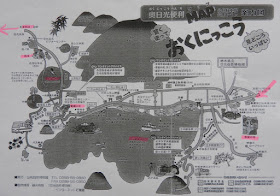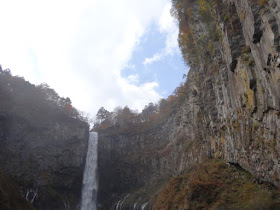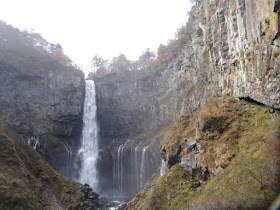 |
| 添乗員の方からいただいた地図 Our tour conductor gave us this map. |
華厳の滝 (ケゴンノタキ)、
竜頭の滝 (リュウズノタキ)、
湯滝 (ユダキ)
が見られるコースに参加しました。
華厳の滝については下記。
We
joined a Club
Tourism tour
of Autumn Colours in which we could see "Okunikkō Three Great
Falls" :
Kegon
Fall ; ★
Club
Tourism site: ★
About Kegon
Falls,
below.
竜頭の滝 駐車場 / Car park, Ryūzu Water Falls
竜頭の滝 / Ryūzu Water Falls
 |
ここは滝壺にあたり、落口 (オチグチ) には行きませんでした。
この場所にしばらくいて景色を楽しんだり、水音を聞いたりする時間は、もてませんでした。 ツアーは忙しないです。短い時間しかありませんでしたが、感動するには十分。 堪能までできないのが残念。 Here is the basin of the Ryūzu Water Falls. We did not go to the top.
We
could not stay here to enjoy the views and listen to the water sounds
enough. A tour is busy....
it was not to my heart's
content, that's too bad.I had a short time here, and although it was enough to make me impressed, 
Yunoko
Lake flows out down the Yukawa River and then
through Senjōgahara : ★,
and
then down the Ryūzu
Water Falls before
reaching Lake
Chūzenji.
|
 |
落口から滝壺まで、210m
滝に沿って遊歩道ができていますが、途中までで引き返しました。 まあ、そういうコースなのです。 From the Top to the Basin, 210m The walk is along the Ryūzu Water Falls,
although
we only went up a little way and
returned.
Well,
our tour was like this. |
車窓から / From Coach Window
|
戦場ヶ原
戦場ヶ原は、標高1390から1400m、400ヘクタールの広さの湿地帯です。
という神話が名前の由来といわれています。こういう神話が好きです。
Senjōgahara
Senjōgahara means 'battlefield'
in Japanese, because its myth tells that the battle was between Mount
Nantai's God and Mount
Akagi's God for Lake
Chūzenji.
I like these kinds of myths.
|
湯滝 / Yudaki Water Fall
 |
| 駐車場から湯滝まで綺麗な紅葉が続いていました。 There were beautiful autumn colours from the car park to the Yudaki Water fall.  |
車窓から / From Coach Window
 |
| 湯川 / Yukawa River |
 |
| 湯ノ湖 ちょっとミステリアスですね。 Yunoko Lake It is a little mysterious, isn't it?
観光バスが走っている道路は、"日本ロマンチック街道"です。
下記ウィキペディア
"沿線の自然が日本において最もドイツ的自然環境を持っているからだといわれる"
そうなのですか〜....。
The
coach takes us along this road which they call "Japanese
Romantic Road".
The
name came from "Romantic
Road" in Germany.
According
to Japanese Wikipedia (
translated by me)
"They
say Japanese nature along this road looks most like some of the
natural environment in Germany."
Is
this really so?
湯ノ湖 が小さい...日光を離れて行きます...
美しく壮観な景色をたくさん見て、魂が浄化された気がします。
ありがとうございました!
Yunoko Lake is small... We are leaving Nikkō...
I saw many beautiful and spectacular views and then I felt my soul was purified.
Thank you very much!
|






































